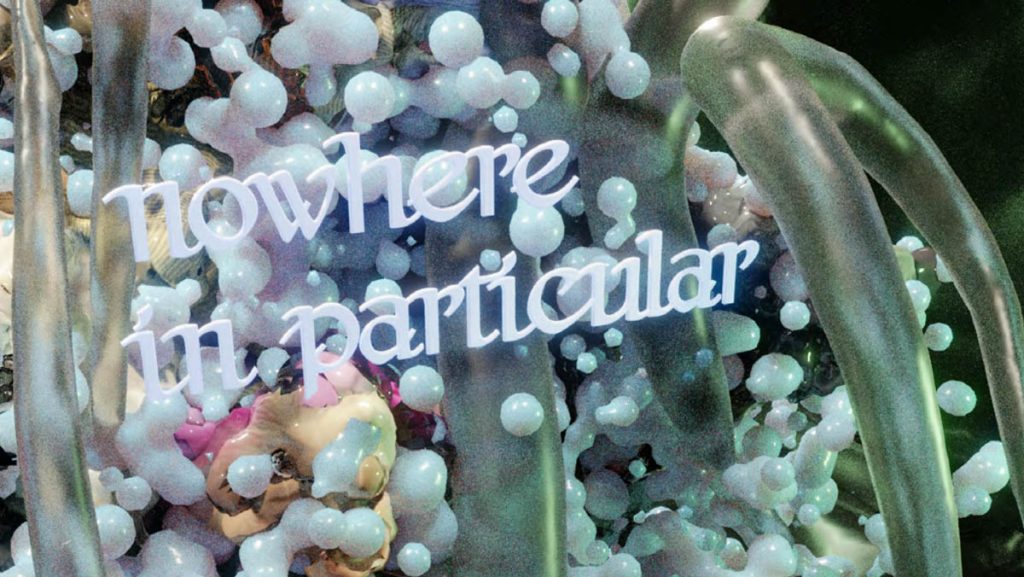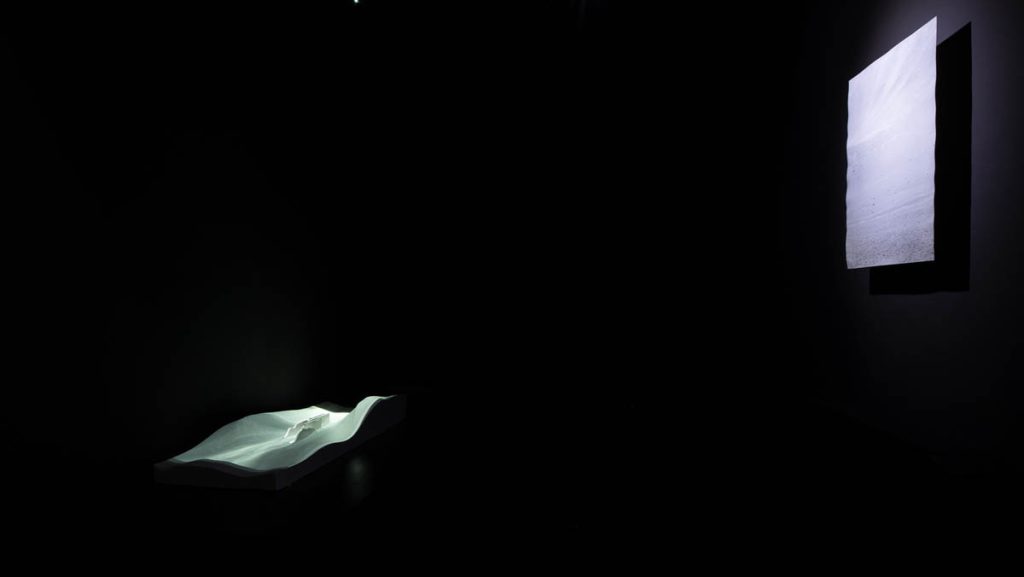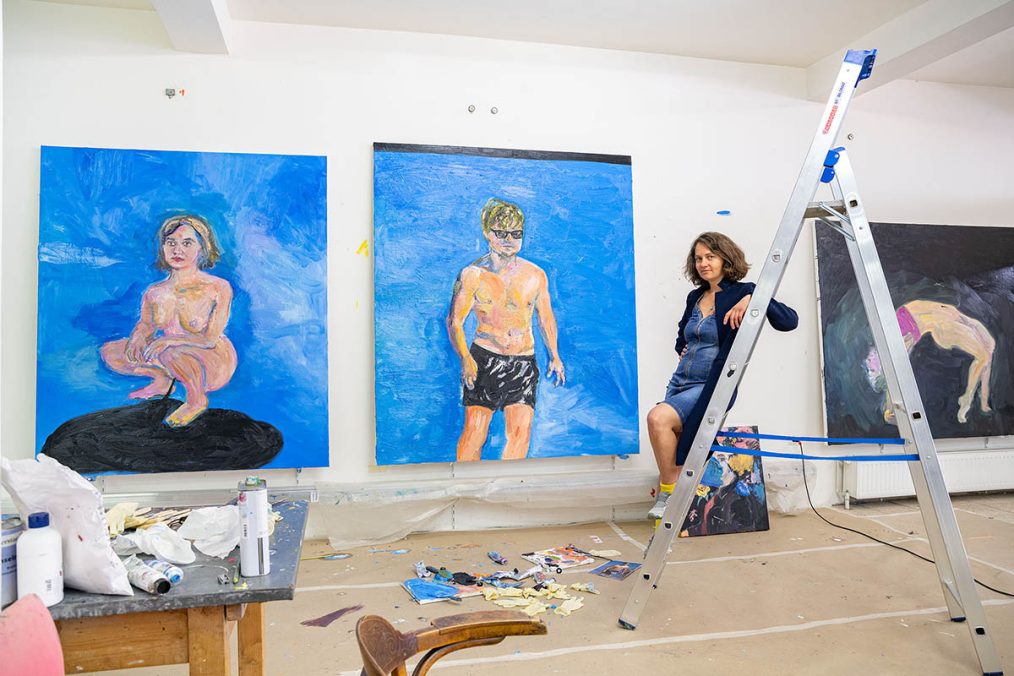
A new portrait of Leonardo DiCaprio emerging from the water in swim trunks and shades looks like a Fata Morgana on a Mallorca beach. However, her yet unfinished self-portrait, against the same blue background, is far from being dreamy, but rather anxious and disturbing. On the opposite wall, there are works painted earlier this year, among which huge and dramatic ‘True Love’ stands out; one could hardly recognize Oksana in a girl with curly yellow hair widely smiling from the canvas. On the floor, among oil paints and brushes, printed pictures of the same girl in a shiny white gown are scattered.
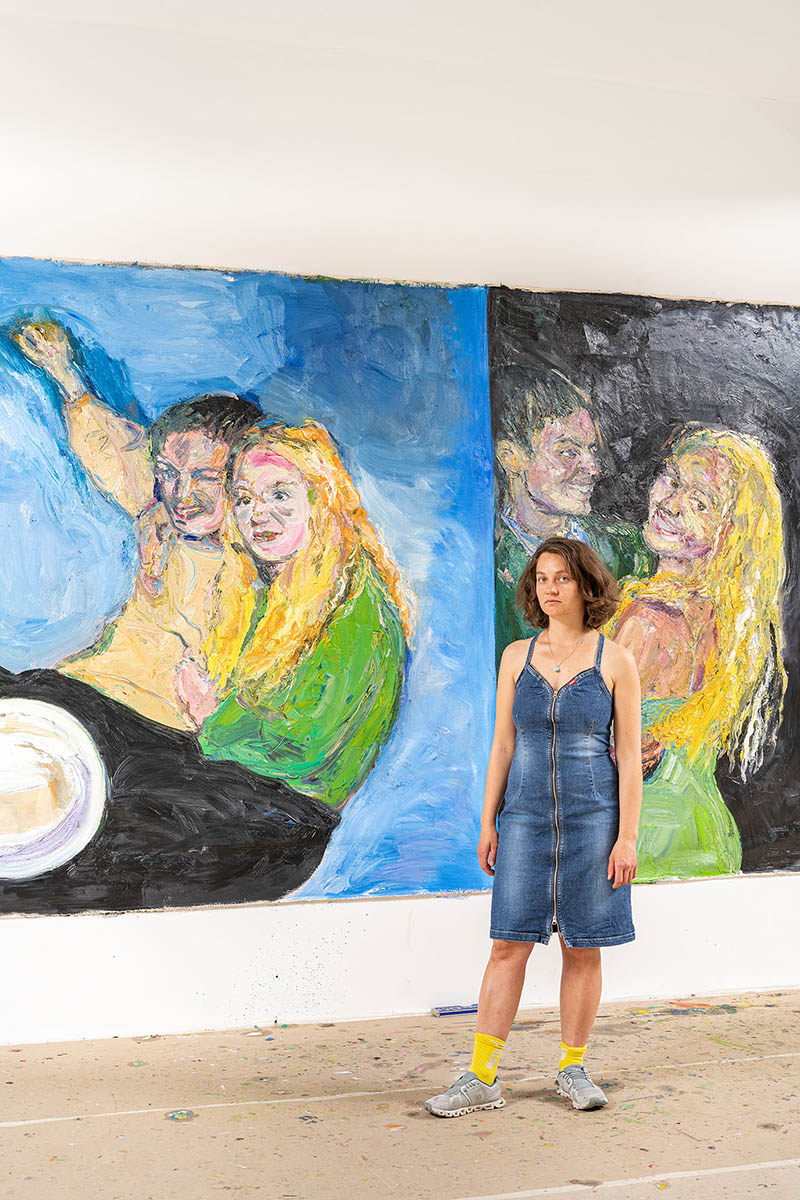
Liudmila Kirsanova: Portraits and especially self-portraits are a very important part of your work. However, recently a new type of self-portrait has appeared among others – I would call them images from the past. Painted from the private photo archive, they show you at different moments of your childhood and adolescence. What has sparked this revision of personal memories?
Oksana Zmiyevska: Yes, you’re absolutely right. Recently I’ve started to do more biographical canvases, but it’s not something radically new, it comes in waves in my practice. And now, when this terrible war in Ukraine was unleashed, I felt very strongly connected to the time I spent there, in my home country. I grew up in Crimea and moved to Vienna when I was 16. The war triggered an immediate urge to paint my first love, a person with whom I experienced two wonderful years, my last years, in Ukraine. And another painting right there, with a child surrounded by smiling faces towards him, this one I had finished before the war, and it represents my struggle with the traumas of the past. For a very long time I was painting different sitters, I needed a break and… so I turned to myself.
How does it differ to paint a self-portrait in front of a mirror and from a photo taken 20 years ago? Can you still identify with a person in the pictures? How does it feel to meet your own self from the past?
It is very hard to unfold a story in a portrait, it’s not a book or a diary, you can’t look into one’s mind. Totally, I see myself in these new paintings, but at the same time it’s a different person. There is something funny about all this – she is blondie, very young, happy, she is somebody else, but simultaneously… also me. When ‘True Love’ was finished, I felt like I changed something about this memory; it’s not by any means got drained but reworked in a way. Now when I look at it, I feel differently. So before and after the painting – there are two different worlds.
You said the war triggered you to revisit the past…
I felt immediately connected to it. All these memories emerged like it all happened yesterday. The same day the war began I called my first love, whom you see there, painted next to me, he still lives in Crimea, we talked through the night – he was and is my happiest memory from those times. Our romance finished abruptly with my relocation to Austria and honestly, I have never reflected on that dramatic cut off, just blocked it within. And when the war broke out, I suddenly felt a strong need to re-experience that happiness.
Do you think that artists should respond to the social catastrophes and disasters happening in the world? Did you feel responsible to reflect on the war in your paintings?
I’ll give you an example. The war in Ukraine made people politicise my work – suddenly they’ve started seeing things on top of the other things, they’ve taken a new perspective on my paintings, even older ones, those made much longer before this tragedy. Have a look, there is a nude self-portrait right there, you see me squatting and pissing, against a sky-blue background. It is a new thing I’m currently working on. At first, I painted the urine puddle yellow, like it should be, but then I realised that someone might misunderstand me and see it all together as a reference to the Ukrainian flag – blue and yellow. So, I decided to change it to black. And now I like it even more. It would have been totally wrong to ignore this controversial situation. I’d hate to think of hyping it up… I’m not a political artist, I do reflect on what touches, worries, excites me. And of course, this war in my home country wounded me badly. And I painted these new works about Ukraine and did an open studio soirée to show them; it was crucial for me to share them with the world. The same story is about nude female portraits and self-portraits – it’s not an intentional feministic act for me. It concerns the presence of female bodies indeed, but it’s not a direct political statement. I’m just conveying my experience of being a woman and seeking to understand other women out there.
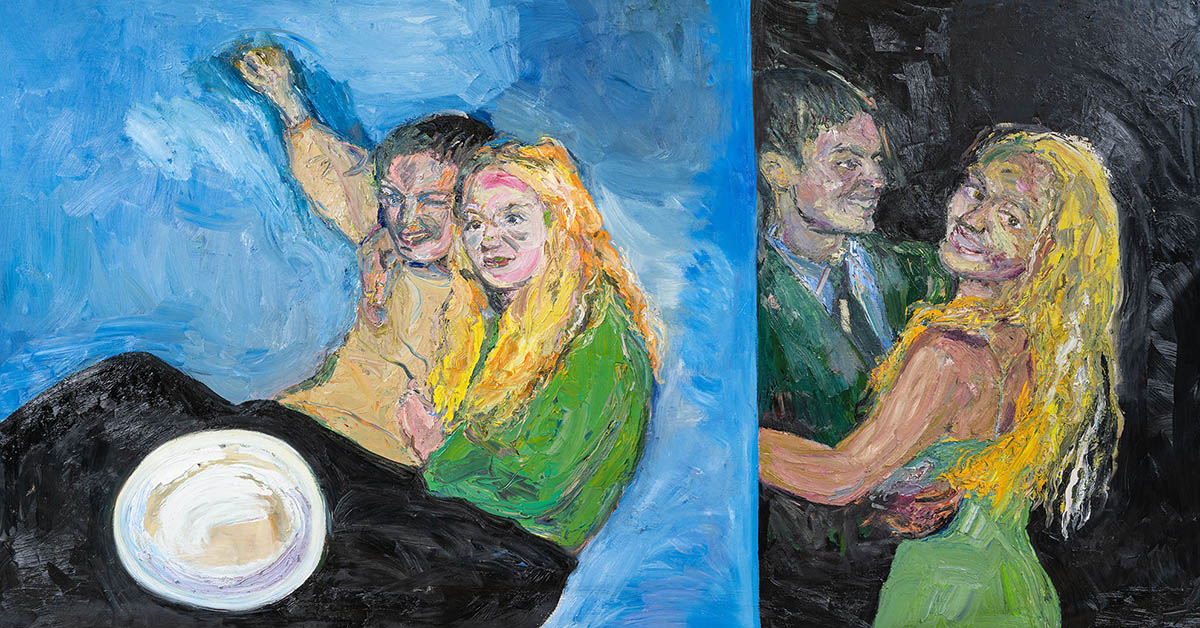
Speaking broadly about your interest in painting self-portraits, where does it come from?
I love to paint faces, and since I know and understand mine the most, I often address it in my art. Also, I’m very interested in psychology and read a lot around.
For your last solo show at Galeria Pelaires in Spain, you created an exciting narrative by juxtaposing the series of self-portraits with portraits of Leonardo DiCaprio. What was this imagined dialogue or conflict about?
It was a joke, an ironic gesture. However, also very dreamy – yes, to see us together, on the same stage. At least in painting it’s possible (smiling). So why not to do this (laughing)? It is also about the contrast indeed, about the conflict and that’s why it’s so funny. The further the distance is, the more the contradiction stretches, the more comic it can become.
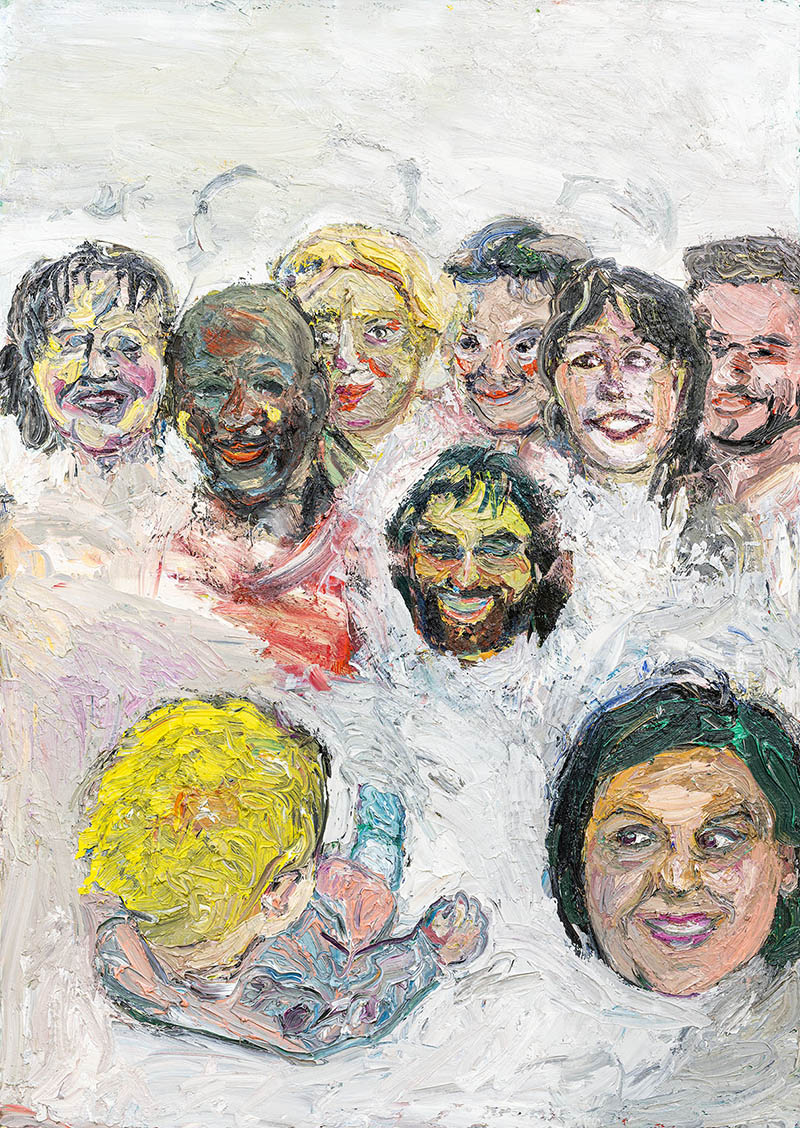
Your self-portraits are open and honest. Does it come from deep self-understanding and self-acceptance? Or does it come from the desire to observe and discover yourself?
Here, you’ve got the very point of it. Self-portraits give me the opportunity to discover the world, through myself. I’m not afraid to portray myself nude or pissing or depressed or positioning myself next to Leonardo. I want to get as much closer to myself and to understand as much as possible. I see a canvas like a mirror, and I apply pigments like if they were my hands touching the reflection, there is no distance in these moments between me and the canvas. It can be a dialogue, a fight, or falling in love… It’s very sensitive and childish…
It demands much courage. Your female images are very strong, because they don’t hide, don’t pretend, they’re open towards the viewer. Does your interest in psychology inform the way you paint portraits and self-portraits?
Unconsciously. It’s not like I try to analyse, but it comes naturally because I do like to look at people, to try to understand them, to paint them. Yes, unconsciously.
The way I understand your working process is that you have a person or group of persons sitting for you or you use a mirror for self-portraits. I believe you haven’t yet had a chance to draw from Leonardo DiCaprio at your studio…
For me to be a painter means always to be in transition. Long time I was painting from models, and I did it very swiftly, it was the way to capture the character. Lately I wished I could dedicate more time to the painting, immerse myself into it and so I’ve decided to change my approach. Before my friends and colleagues used to come to my atelier and I painted them – it was like a jam session, very easy-going, four hours of chatting, drinking coffee, painting. Now I have switched to painting from found photos and fantasy, because then I can really dive into the painting, spend much more time with it, more layers appear. And I won’t stop painting Leonardo (laughing), I’m still too interested in painting him.
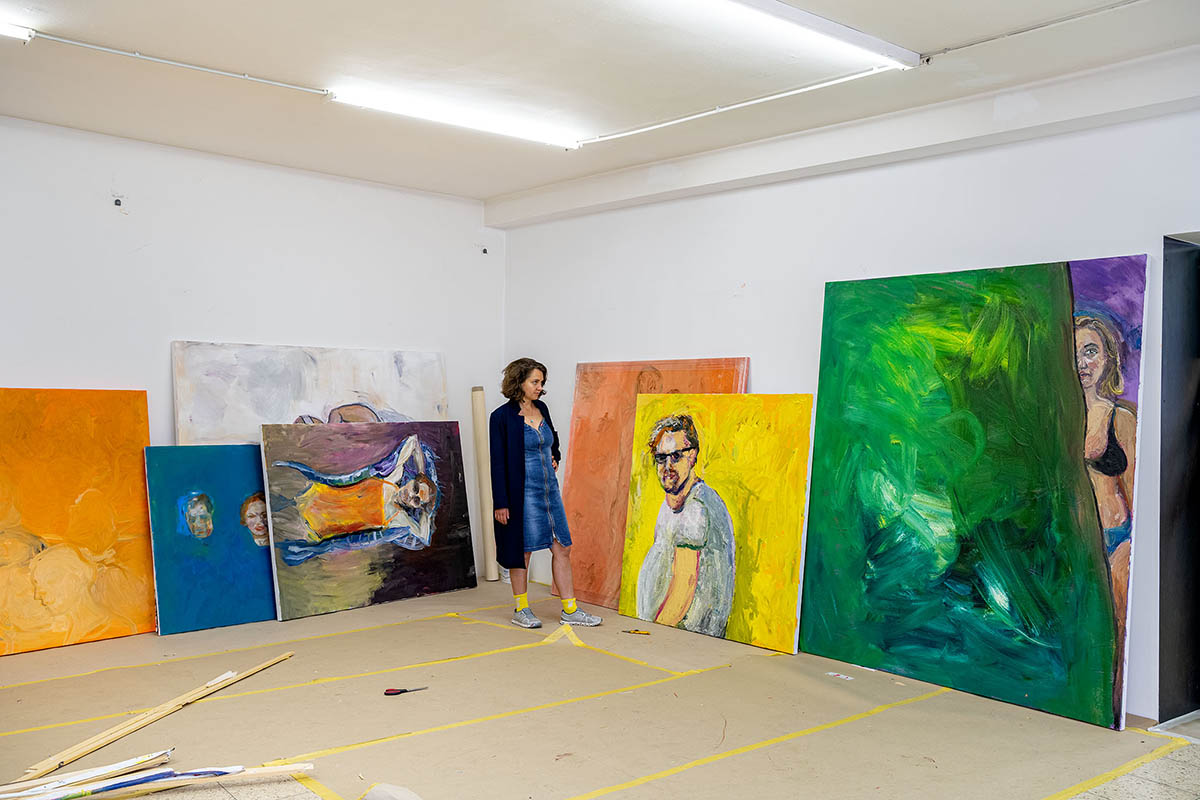
Why?
Painting Leonardo is about being free. There is a lot of humour. There are no limits. Can you just keep this – ‘there are no limits’ instead of everything else I’m saying here? It is not about my feelings; it is about fun. And I do extremely enjoy that I can have fun while painting… finally (laughing). Isn’t it hilarious? It’s all a big joke for me. And maybe one day he’ll call me… Anyway, I’m having a wonderful time painting him. When I do a self-portrait, it always ends up in a drama – this black puddle in the new piece, you see – … but when I paint Leonardo, I flow, I relax. And also, since last year I’ve been working in this new big studio that allows me to experiment with the sizes of my paintings, so you see many of these new big canvases. It’s an opportunity to pour all my energy into the work. I’m not a person of small formats.
What artists inspire you along your journey?
Recently I have discovered a fantastic artist – Leon Kosoff; thick layers, marvellous paintings. Then Chaïm Soutine. Then Cecily Brown. Miriam Cahn. Regarding portraits… Marlene Dumas. From other disciplines, for example Nan Goldin in photography. The current Munch exhibition in Albertina inspired me immensely. He used very little but took the most out of it; very strong emotions achieved through a very reduced manner. His paintings influenced the way I did ‘True Love’. At the end of the day, I’m an old-fashioned painter, you know…
About Oksana Zmiyevska. Born in 1987 in Crimea, she currently lives and works in Austria. Zmiyevska studied painting at the University of Applied Arts Vienna. Along with various private collections around the globe, her artwork is included into the state collection of the City of Vienna.
Oksana Zmiyevska – www.oksanazmiyevska.com
About the writer: Liudmila Kirsanova is an independent curator and writer, whose research is focused on autofictions, storytelling, and politics of belonging. In 2019 she became the finalist of the curatorial award Bonniers Konsthall, Stockholm. Curating international and domestic projects, Kirsanova has been advocating and promoting female artists, in particular those from non-Western cultures.




